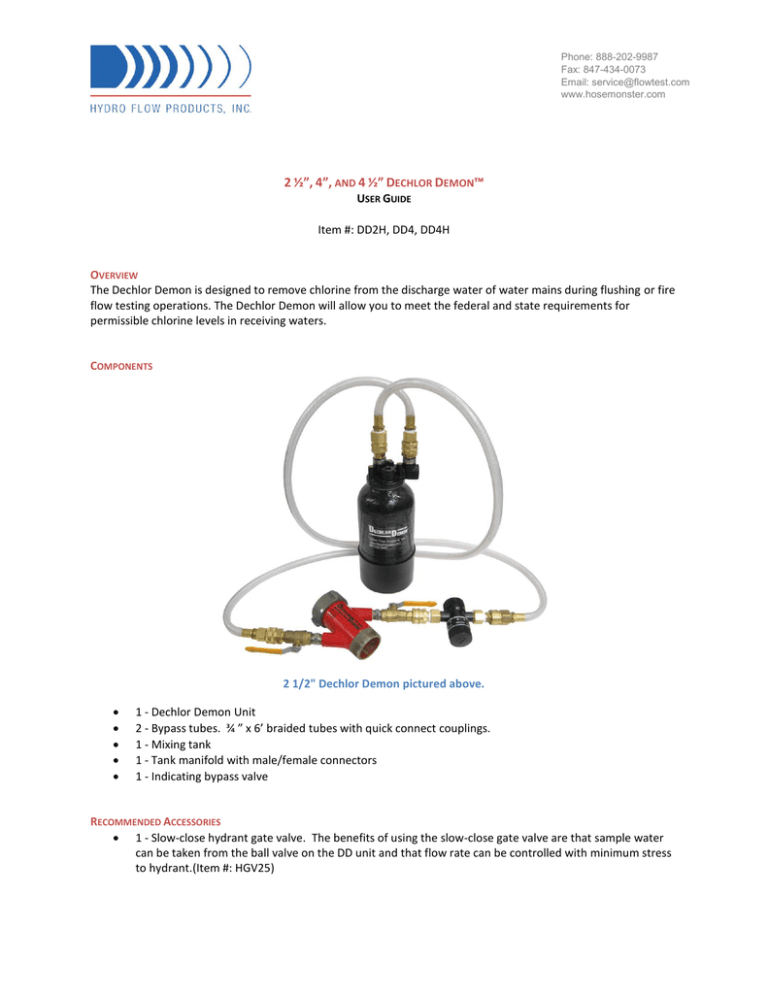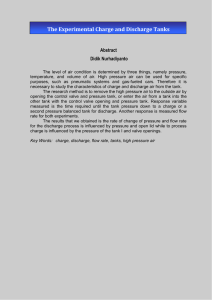
Phone: 888-202-9987
Fax: 847-434-0073
Email: service@flowtest.com
www.hosemonster.com
2 ½”, 4”, AND 4 ½” DECHLOR DEMON™
USER GUIDE
Item #: DD2H, DD4, DD4H
OVERVIEW
The Dechlor Demon is designed to remove chlorine from the discharge water of water mains during flushing or fire
flow testing operations. The Dechlor Demon will allow you to meet the federal and state requirements for
permissible chlorine levels in receiving waters.
COMPONENTS
2 1/2" Dechlor Demon pictured above.
1 - Dechlor Demon Unit
2 - Bypass tubes. ¾ ” x 6’ braided tubes with quick connect couplings.
1 - Mixing tank
1 - Tank manifold with male/female connectors
1 - Indicating bypass valve
RECOMMENDED ACCESSORIES
1 - Slow-close hydrant gate valve. The benefits of using the slow-close gate valve are that sample water
can be taken from the ball valve on the DD unit and that flow rate can be controlled with minimum stress
to hydrant.(Item #: HGV25)
RECOMMENDED DECHLORINATING AGENTS
VC Mini-Tabs (ascorbic acid)
Vita-D-Chlor (ascorbic acid)
Sodium Sulfite Tablets
OPERATION
The Dechlor Demon diverts some of the flowing water through a bypass and into a mixing tank that contains a
concentration of dechlorinating agent. This resulting concentrate continues through the bypass and is injected
back into the flowing water. The chlorine is neutralized upon contact with the solution.
1)
2)
3)
4)
5)
6)
7)
8)
9)
10)
11)
12)
13)
Attach swivel coupling of DD unit to the hydrant port.
Attach a slow-close gate valve to the outlet end of the DD unit.
Attach a discharge hose (and Hose Monster®) to the male end of slow-close gate valve.
Close the three valves: Inlet ball-valve, Outlet ball-valve, and Slow-close hydrant gate valve
Add dechlorinating agent tablets to mixing tank.
Thread manifold onto mixing tank. Hold tank in the horizontal position while installing manifold so that
the inlet tube doesn’t bind against the tablets.
Attach bypass tube and indicating valve to inlet side of tank manifold and to the DD unit. (Male fitting of
DD unit. Female fitting of tank manifold)
Attach the discharge tube to the DD unit, but not to the tank manifold yet. (Female fitting of DD unit.
Male fitting of tank manifold)
Check that the two ball-valves and the slow-close gate valve are closed.
Open indicating bypass valve half way. No water should be flowing at this time. (If this is a flow test,
bleed air through gauge cap and take static pressure reading when hydrant is fully open and the pressure
stabilized.)
Open the ball-valve on inlet side of DD unit to fill tank. Water will exit the tank manifold outlet when tank
is full. Then close ball-valve.
Attach remaining tube to tank manifold.
Close both ball-valves.
Begin flowing water.
14) Put tank in upright position.
15) Open both ball-valves fully.
16) Open the slow-close gate valve as would normally be done for flow testing or flushing.
17) Immediately check chlorine level of discharged water.
18) If too high a chlorine level is present, open indicating bypass valve to ¾ open or add more dechlorinating
agent into the tank.
19) If there is zero chlorine in the discharge water, the inlet indicating bypass valve may be closed slightly to
conserve the use of dechlorinating agent.
20) Adjust indicating bypass valve as appropriate.
2
Check chlorine level as necessary and adjust indicating ball valve or add agent to the tank to achieve desired level.
Since many factors can affect the dechlorination reaction, always test treated water for residual chlorine levels to
assure complete dechlorination.
DETERMINING QUANTITY OF DECHLORINATING AGENT
There are three variables in determining how much agent to put in the tank.
1) Chlorine content.
2) Flow rate through hydrant or pump.
3) Concentration of agent in mixing tank.
All of these variables change during the flow test or flushing operation. Monitor chlorine levels as required to
maintain desired level.
Example:
Put four tabs in the tank and fill it with water. Open both ball-valves fully. Open indicating ball-valve half way.
Open slow-close gate valve as would normally be done for flow testing or flushing. Check the discharge for
chlorine level. If the chlorine level is too high, add tabs to the tank or open the Intake ball-valve more. If the
chlorine is completely neutralized, it could be the result of using too much dechlorinating agent. Too much
ascorbic acid or sodium sulfite is not known to damage the environment but it is costly. Adjust the indicating
bypass valve one-half way and check the chlorine level again. Open or close the bypass valve until the desired
chlorine level is achieved. Note that the tabs are dissolving as water flows through the bypass. The chlorine level
will need to be monitored and the indicating bypass valve adjusted accordingly.
MAINTENANCE
Rinse inside of tank at end of day to avoid residual build up.
Wipe down the product with a damp rag after each use to remove dirt and debris. To reduce corrosion on
brass, aluminum, or steel fittings apply WD-40 or Gibbs Brand Lubricant, then wipe with a rag.
Replace damaged or worn gaskets.
CAUTION
ALL CONNECTIONS IN THIS ASSEMBLY MUST BE ATTACHED SECURELY. DIRECT WATER DISCHARGE AWAY
FROM ANY PEOPLE OR PROPERTY THAT MAY BE AFFECTED. THE USE OF THIS PRODUCT INVOLVES HEAVY WATER
FLOW WHICH CAN RESULT IN SERIOUS INJURY OR DEATH IF USED IMPROPERLY. THE MANUFACTURER AND ITS
DISTRIBUTORS ARE NOT RESPONSIBLE FOR ANY DAMAGE OR INJURY CAUSED BY THE USE OF THIS PRODUCT.
PRODUCTS THAT HAVE BEEN ALTERED OR MODIFIED IN ANY WAY POSE A SAFETY RISK AND WILL VOID THE
MANUFACTURER’S WARRANTY.
© 2013 Hydro Flow Products Inc. All rights reserved.
3




